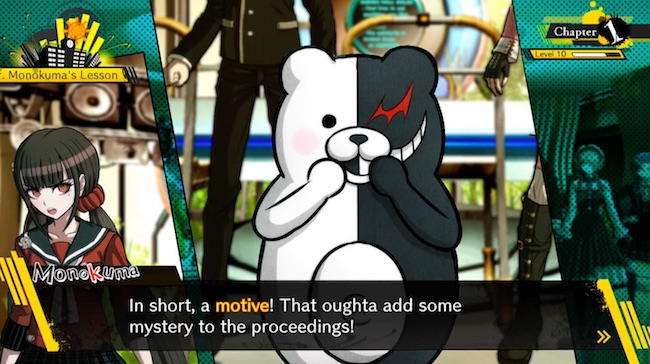
As a massive fan of puzzles, I have always been regularly won over by the murder-mystery visual novel genre. Phoenix Wright first did this years ago, but its simple mechanics have worn on me over the years. Enter Danganronpa, however, which is built in a similar vein, but also adds high-energy nonsense, extreme story arcs, and more active gameplay mechanics. Having followed the series eagerly over the years, I was eager to see what the premise behind its newest instalment, Killing Harmony, would be.
For those of you who’ve never encountered Danganronpa before, a summary is essential. The premise behind the main line of the series is simple enough: sixteen high-schoolers are trapped in a school and forced to compete in a ‘killing game.’ To earn the right to leave, one must successfully murder another student but in such a way that they are not revealed as the murderer in the subsequent trial. Success means freedom at the cost of the lives of all remaining students, while failure means your own death and the continuation of the competition.

Gameplay takes place in two parts, referred to as “School Life” and “Class Trials,” separated by a brief “Investigation” segment. In School Life, the experience is just like any visual novel, in which the students explore the school and try to make sense of the mystery of the overall story. Once a murder is committed, and the survivors are given a brief period to examine the area for evidence, the “Class Trial” begins. By presenting evidence to prove any contradictions in testimony and completing a variety of mini-games, the students will work together (mostly) to come to their ultimate decision of the likely culprit. Rinse and repeat until the end, and you’ve got yourself some Danganronpa.
At this point, I would stress all people new to the series to stop reading the review now and decide if this sounds the sort of thing that would suit you. If you are at all interested in this series, I urge you to immediately play at least the original two games in the series first, as it is pivotal to your enjoyment here. Luckily, Spike Chunsoft released Danganronpa 1.2 Reload to give you easy access to both of these. While they’re not for everyone, as is the case with most visual novels, if the premise intrigues you and you don’t mind a healthy serving of over-the-top anime tropes then you’ll find the same joy I did.
Now that all the new people are gone, I’ve got a separate message for all the returning fans: go get this game. There have been some changes, which I’ll get into later, but this is still undeniably Danganronpa. While there are no story-spoilers ahead, I will discuss some mechanics you may enjoy discovering for yourself. If you’ve been wanting more of it, it’s here for you right now, and it’s everything you wanted it to be.

Having successfully suggested my entire audience cease reading, there’s no better time to start discussing my impressions: let’s start with the story. While I can’t dig into my specific feelings about plot points without risking massive spoilers, I can at least indicate that the story was at least on-par with previous Danganronpa games. The early parts were much faster, with a build-up to the finale that had me eager for every line of dialogue. Most of the twists came out from unexpected directions, and the overall mystery of the tale was a constant driving factor – it’s everything you could ask for in a murder-mystery tale.
The students of this killing game are perhaps the best designed of the groups so far. Visually, they’re as vibrant and varied as ever, and brought to life with some top-notch voice acting, particularly evident during some of the darker points in the story. There are some stand-out characters this time around with very unusual personalities, resulting in some very fascinating cases. Each character’s back-story isn’t explored as much as in prior games, but I feel this was a good move: these are better implied by character behaviour than explained through lengthy cutscenes.
Turning to the Class Trial system, much of the classic Danganronpa experience has returned: discussion is still run mostly through Non-Stop Debates with occasional mini-games to break this up. The fun of the Non-Stop Debate system was perfect from the original, so there’s been no real need to refine it, but a slight alteration was made nonetheless. Instead of only arguing by presenting evidence, you can now redirect conversation with a lie, inverting the meaning of any piece of evidence with your false testimony. This element intrigued me from the outset but didn’t do much to change the overall experience.

The other mid-trial mini-games are where the most significant changes were made: where once there were only two or three, there’s now a total of eight different mini-games. This mix adds a tonne of variety to the trial process, and each seems to have a particular purpose from a design perspective. For example, Psyche Taxi operates as a means to confirm the player has understood basic facts as it’s straightforward and tends to recap the logic of the recent discussion. On the other hand, Hangman’s Gambit V3.0 requires the player to have already formed a solid theory on the case and have the ability to intuit an answer from an often vague question. They’re all well designed and fun, and I was always excited to see one coming up.
Naturally, the question of the difficulty comes up with any game like this; if the player can work out the entire case from the get-go, the trial becomes far less engaging. Most of the cases were able to keep a couple of steps ahead of me in the sweet-spot that encourages an ongoing re-examination of evidence without being overly punishing. Unfortunately, two stood out to me as a little off: one which I couldn’t get my head around until very late in the trial, and another that was so easy that I was penalised for thinking too far ahead of the students. It certainly didn’t ruin the experience, but it was a source of frustration.
Similarly frustrating is the inevitable problem that all games in this genre suffer from: unclear question/answer combinations, by which I mean any scenario where you are faced with a broad statement and need to show which specific piece of evidence proves, or counters, the claim when multiple could be considered applicable. It shocks me that no game that I’ve played in this genre has ever managed to avoid some instance of this. That said, even playing on the hardest difficulty, I was able to force my way through these sections without ruining my entire case: they’re infrequent enough that consistent insight elsewhere will make up for any questions that end up causing you significant damage due to this kind of vagueness.

Any game that falls into the genre of “visual novel” becomes immediately more difficult to recommend to the uninitiated, but I feel that Danganronpa gets around this on its premise alone. The intrigue of the killing game and the over-the-top characters draw in your interest, and the ultimate mystery of the plot will lock you in. While this latest entry doesn’t do much to innovate the series, it’s more of the good stuff that fans have loved in the past with some quality of life improvements and fun add-ons. We just needed to believe in hope, after all.











